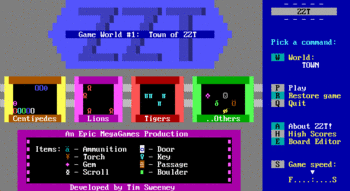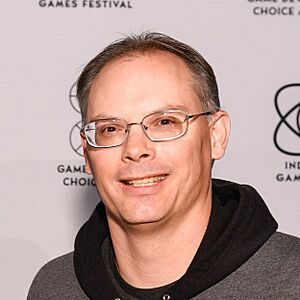ZZT facts for kids
Quick facts for kids ZZT |
|
|---|---|

Title screen of Town of ZZT
|
|
| Developer(s) | Potomac Computer Systems |
| Publisher(s) | Potomac Computer Systems |
| Designer(s) | Tim Sweeney |
| Platform(s) | MS-DOS |
| Release date(s) |
|
| Genre(s) | Action-adventure, game creation system, puzzle |
| Mode(s) | Single-player |
ZZT is an old computer game from 1991. It's an action-adventure and puzzle game. What makes it special is that it's also a game creation system. This means players can make their own games inside ZZT!
The game was made by Potomac Computer Systems for MS-DOS computers. Later, in 1997, it became freeware, which means it was free to play. In ZZT, you control a smiley face. Your job is to battle creatures and solve puzzles. You do this on different grid-based levels called "boards" in a chosen world.
There are four main worlds to explore. In these worlds, you find and use items like ammo, bombs, and scrolls. Your goal is to reach the end of the game. ZZT also has a special tool built right into the game. This tool lets you create your own worlds using the game's own simple programming language, called ZZT-OOP.
Contents
How to Play ZZT
ZZT is played from a top-down view. You see your character and the level from above. You play as a white smiley face on a dark blue screen. You can move this smiley face in four directions: up, down, left, and right.
You can interact with things in the game by touching them or shooting them.
- Touching items like ammo, gems, torches, and keys adds them to your status bar.
- Ammo lets you shoot bullets at enemies.
- Gems give you health and act as money.
- Torches light up dark areas around you.
- Colored keys open doors of the same color.
Other items you'll find include bombs, doors, and scrolls. There's also a special type of item called an "Object." These Objects do different things based on simple scripts written in ZZT-OOP. For example, an Object might give you health or shoot bullets at you. You can save your game at any time. This lets you stop playing and come back later exactly where you left off.
Exploring Game Worlds
ZZT game worlds are made of many grid-based boards. These boards are connected to each other. You can move between boards by walking to the edge of the screen or by using teleporters.
When ZZT first came out, it had six game worlds. Four of these were main game worlds:
- Town of ZZT starts in a central area with buildings and exits.
- Caves of ZZT begins in a simple area with torches and a scroll.
- Dungeons of ZZT has a straight path at the start with locked gates.
- City of ZZT opens in a city street that acts as a hub.
Two other worlds were included for different reasons. Guided Tour ZZT's Other Worlds showed off parts of each game world. Demo of the ZZT World Editor was like a museum. It showed all the items, terrains, and creatures you could use in ZZT.
Your main goal in the game is to reach the final board. You do this by collecting purple keys to open locked doors. Or you might need to gather specific objects throughout the world.
Boards and Challenges
Boards in ZZT can be either action-packed or puzzle-based.
- Action boards are where you fight creatures. These can include lions, tigers, and bears. If creatures, bullets, or stars touch you, you lose health. If your health runs out, the game ends.
- Puzzle boards involve solving tricky problems. You might need to move boulders, sliders, and pushers. Some puzzles are mazes that can have invisible walls or teleporters. Be careful, some puzzles can trap you! If you get stuck, you might need to load an earlier save.
Creating Your Own Worlds
ZZT has a built-in editor. This tool lets you make your very own game worlds. When you start, you get a blank screen with yellow walls around it.
The editor lets you:
- Add and arrange items, creatures, and different types of ground.
- Connect different boards to create a whole world.
Each board can have its own special settings. For example, you can add a time limit to a board. You can also make a board dark, so players need a torch to see. Or you can limit how many bullets can be on screen at once.
The game uses simple text characters to show everything. It supports 16 colors. The editor lets you use seven colors for most objects. There are also limits on how many objects you can place on each board. Players later found ways to add more colors using special commands.
The game uses the PC speaker for sounds. It can play seven notes and different drum-like sounds. Sounds play during gameplay, and you can even make custom sounds using scripts.
How ZZT Was Made
ZZT was created by game programmer Tim Sweeney. He was a student studying mechanical engineering at the University of Maryland. Tim first started making ZZT as a text editor. He used a programming language called Turbo Pascal. At the time, Tim didn't know how to program graphics. He only had an older computer and a basic keyboard.
Tim didn't like the text editors that came with other programming languages. So, he decided to make his own. He started playing around with adding "collision" to text characters. This meant characters could bump into each other. He also made the cursor (the blinking line on the screen) into a character you could control. He soon realized it was more fun to turn it into a game. He added bullets and creatures to fight.
From there, he designed his first levels using text files. He created different boards that were like the old game Adventure. He kept adding new things to the game and its editor. Tim studied during the day and worked on his game at night. The text-based graphics allowed him to create fun ideas. He could make talking trees or interesting characters easily. Most of his ideas were his own. But he did get one idea, the bomb, from another game called Kroz.
It took Tim about six to nine months to make ZZT. He spent less than 1,000 hours on it. The game was built with about 20,000 lines of Pascal code.
Sharing the Game
Tim shared his game with friends and kids in his neighborhood. He saw how much they enjoyed playing it. This made him realize that making games was a great way to share something with the world. He also saw that he could earn money from it. So, he decided to sell the game.
He was inspired by how other companies like Apogee sold their games. They used a method called shareware. This meant you could get the first part of the game for free. If you liked it, you could pay to get the rest. Tim encouraged people to share the free part of ZZT on computer networks and bulletin board systems.
Tim ran his company from his bedroom. People would mail orders to his parents' address. He would then send them the rest of the game on floppy disks. During development, he even wrote to another game developer, Scott Miller, for advice. Miller wrote back with helpful tips and encouragement.
Tim chose the name "ZZT" so it would be listed last in shareware lists. This made it stand out. A fan later came up with a funny meaning for ZZT: "Zoo of Zero Tolerance." Tim liked this idea. ZZT was released on January 15, 1991. The first part, Town of ZZT, and the game editor were free. The other official worlds could be bought. You would get a floppy disk with the purchased worlds and maps. Later, in 1997, all the official ZZT worlds became free to download.
ZZT's Impact and Legacy
ZZT was a big success for Tim Sweeney. He was earning about $100 a day from the game. This convinced him that he could make a career in the video game industry. In October 1991, he changed his company's name to Epic MegaGames. This company later became Epic Games, known for games like Fortnite.
Soon after ZZT came out, Tim started a contest. Players who bought the game could create their own worlds and send them to him. Over 200 people sent in their custom worlds! The best ones were put into two new game collections: The Best of ZZT and ZZT's Revenge. These were released in 1992. Winners got gift certificates. Some of the designers who made the winning worlds for ZZT's Revenge even got jobs at Epic MegaGames.
Tim later asked one of these developers, Allen Pilgrim, to create a world for the sequel to ZZT. This sequel was called Super ZZT, released on October 15, 1991. Super ZZT was similar to ZZT but had more features. It had more colors in its editor, new enemies, and larger levels. However, Super ZZT never became as popular as the original ZZT. Not many games were made for it, partly because its editor was harder to find.
A New Direction for Epic Games
After seeing the amazing worlds the community made, Tim realized they were as good as, or even better than, his own. He also believed that games with better graphics and sound would sell more. So, he decided to move on from ZZT to work on new projects. One of these was Jill of the Jungle.
Tim Sweeney and Mark Rein, another person at Epic Games, have said that the main idea behind their later hit game Unreal and the Unreal Engine came from what they learned with ZZT. They focused on making games with clean code and good editing tools. This way, other people could easily build their own games. Mark Rein even said that Unreal Tournament felt like a modern version of ZZT because of its strong modding community and powerful tools for creators.
The ZZT Community Today
ZZT created one of the earliest and most active communities of players who made their own content. Many fan-made worlds and editing tools are kept safe on a fan website called Museum of ZZT. ZZT gave people a way to be creative and express themselves. They didn't need to be artists or expert programmers.
As of 2021, over 3,000 worlds have been made using ZZT's editor or other tools. Tim Sweeney has said that tens of thousands of people who now work in the game industry first made worlds in ZZT.
There are also modern versions of ZZT that let you play its games on Windows computers or in a web browser. Another version, DreamZZT, even lets you play on consoles like the Dreamcast and Nintendo DS. People still create new worlds for ZZT today. These worlds have gone beyond the original game's style. They include games like shoot 'em ups, falling block puzzle games, complex role-playing games, and point-and-click adventure games.
The original source code for ZZT was lost in a computer crash. But in 2020, a community developer named Adrian Siekierka rebuilt it. He released the reconstructed source code with Tim Sweeney's permission. Later, in January 2023, the original source code for ZZT 3.0 was officially put on GitHub for everyone to see and use.
ZZT has inspired other games like MegaZeux and PuzzleScript. Many people who made ZZT worlds later became professional video game developers. Some have compared ZZT to games like Minecraft and Roblox. This is because it was a great starting point for new video game developers. Others have noted how ZZT smoothly combines playing and editing, similar to LittleBigPlanet.
Images for kids




